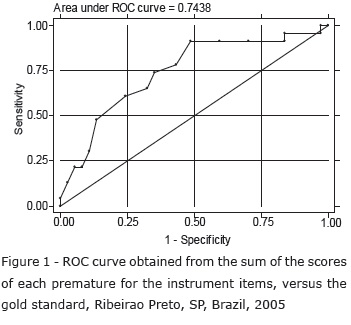INTRODUCTION: Health professionals have great difficulties to establish the adequate and safe time to start breast feeding in preterm infants. There is a need to develop a standardized tool to help health professionals to comprehensively evaluate preterm infant readiness to transition preterm infants´ feeding from gastric to oral, and encourage breast feeding practice in neonatal units. Aims: To clinical validate the accuracy of a Preterm Oral Feeding Readiness Assessment Scale with 60 clinically stable preterm infants. METHODS: Global accuracy, sensitivity and specificity of Preterm Oral Feeding Readiness Assessment Scale cut-offs, compared to milk intake through translactation, were estimated through ROC curves (Receiver Operating Characteristic Curves). RESULTS: The global accuracy of Preterm Oral Feeding Readiness Assessment Scale was 74.38%. The highest sensitivity and specificity were obtained for three cut-offs: 28, 29 and 30. Since higher specificity (75.68%) for the Preterm Oral Feeding Readiness Assessment Scale was found at a score cut-off=of 30 showed higher specificity (75.68%), it should be used as a cut-off score to select initiate breastfeeding the preterm newborns' oral feeding readiness. CONCLUSION: The Preterm Oral Feeding Readiness Assessment Scale is considered valid to assist health professionals to initiate preterm feeding in view of promoting safe and objective breastfeeding.
Infant, Premature; Feeding Behavior; Breast Feeding; ROC Curve


